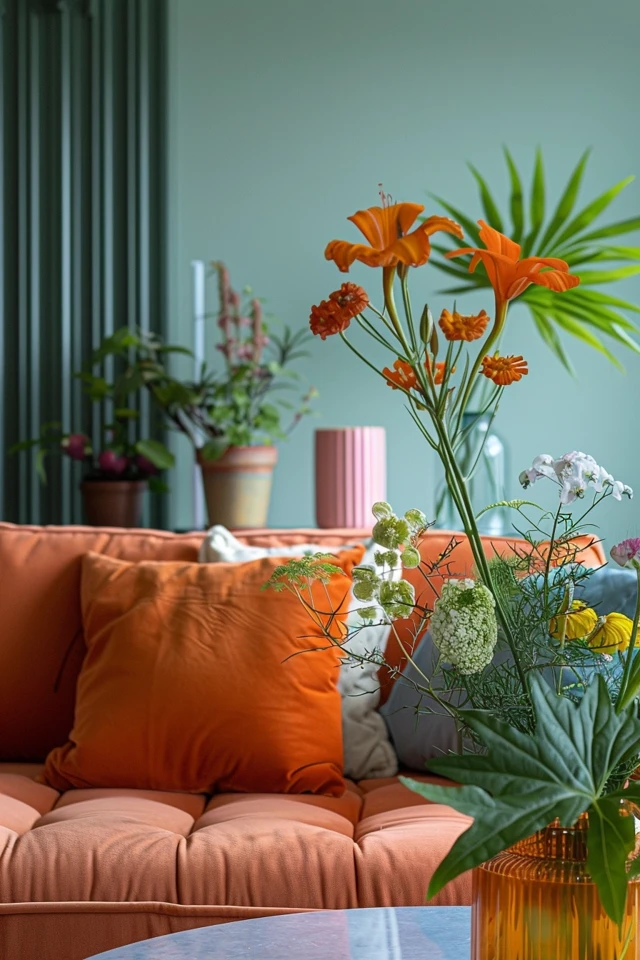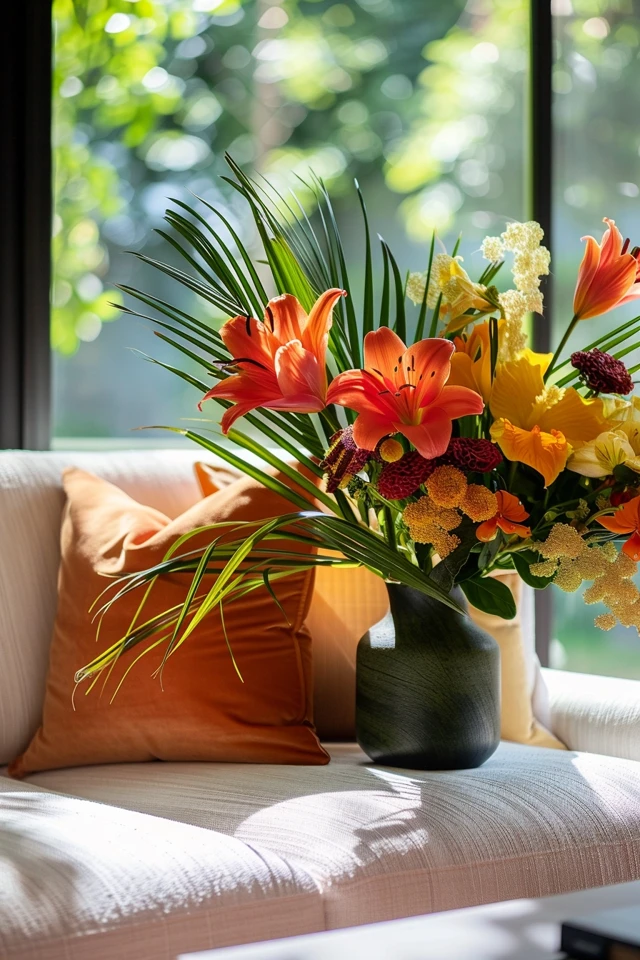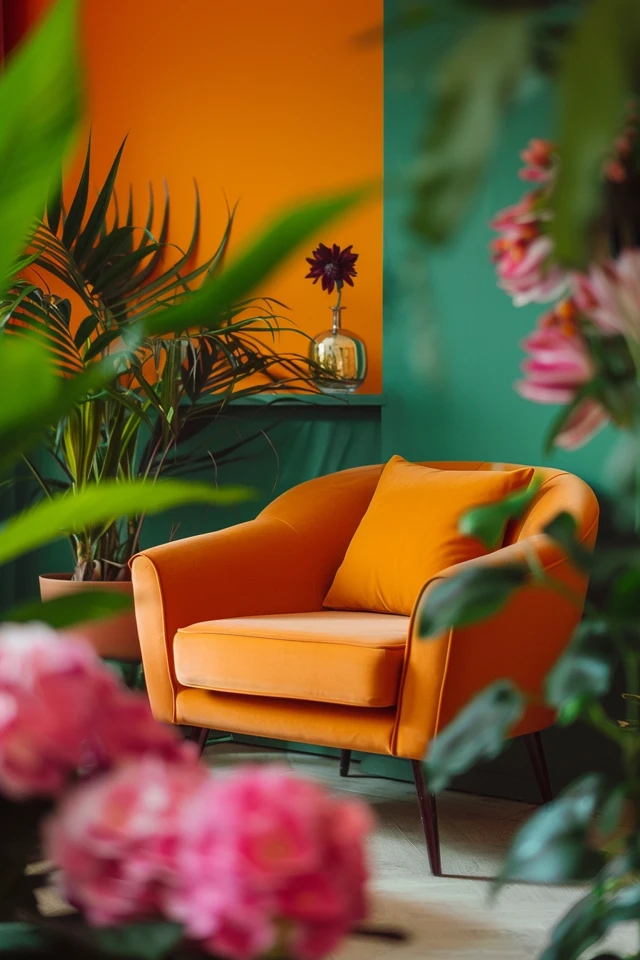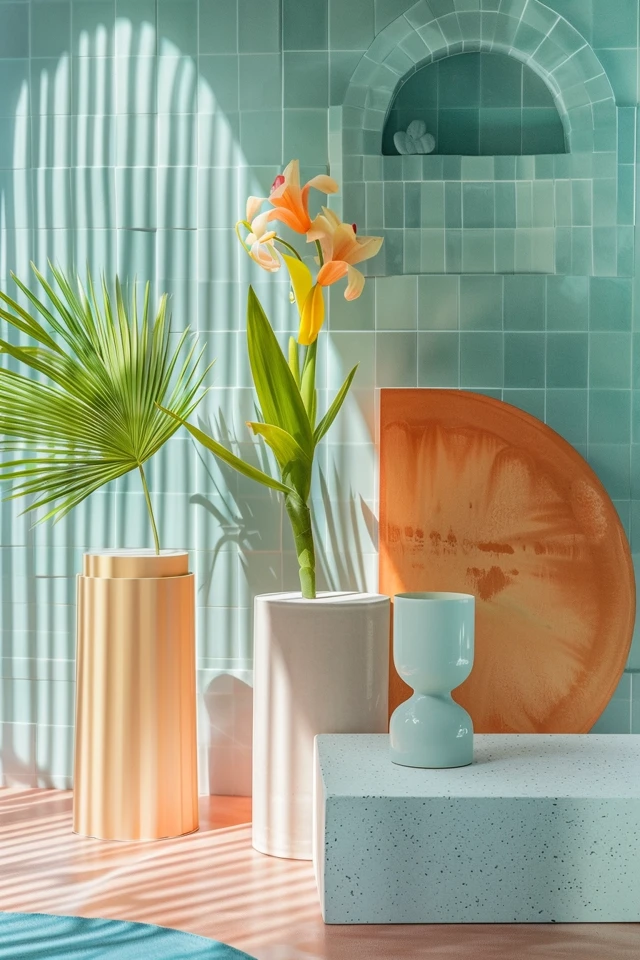Imagine stepping into a space that instantly makes you feel at ease. The ambiance, the lighting, the layout – everything seems to align perfectly, creating an atmosphere that resonates with your soul. That’s the power of interior design. It has the ability to transform a mere physical space into a sanctuary that reflects your unique personality and enhances your well-being.
In today’s fast-paced digital world, the realm of interior design has expanded beyond traditional boundaries. With the rise of online interior design, also known as virtual interior design or e-design services, people can now experience the magic of transforming their living spaces without leaving the comfort of their homes. As an interior design enthusiast myself, I have witnessed firsthand how the fusion of architecture and online interior design has revolutionized the way we create and connect with our living environments.
Key Takeaways:
- Architecture plays a crucial role in shaping online interior design, going beyond aesthetics.
- Ergonomics, lighting, and sustainable design principles directly impact physical and mental well-being.
- Tailoring spaces for specific outcomes enhances the quality of life in various sectors.
- Becoming an interior designer involves acquiring a degree, gaining practical experience, and building a strong portfolio.
- The integration of architecture and AI-driven design software has transformed the field of online interior design.
Ergonomics: Designing for comfort and health
Ergonomics is the science of designing spaces and products that fit the human body and its capabilities. In interior design, ergonomics plays a key role in reducing physical strain, preventing injuries, and improving overall comfort.
When it comes to ergonomics in interior design, several factors contribute to creating a comfortable and healthy space. One crucial aspect is furniture selection. Choosing furniture that offers proper support and adjustability is essential. This includes ergonomic chairs with adjustable height, lumbar support, and armrests, as well as desks with optimal dimensions for a comfortable working posture.
Another important consideration in ergonomics is layout and accessibility. Designing spaces with clear circulation paths allows for easy movement and reduces the risk of accidents. Accessible features, such as ramps and wide doorways, ensure that all individuals can navigate the space comfortably.
Workstation design is also a vital component of ergonomics. Workstation design focuses on optimizing desk heights, chair adjustments, and the integration of ergonomic accessories. This includes incorporating adjustable monitor stands to maintain eye-level viewing, keyboard trays to promote proper wrist alignment, and ergonomic mousepads to reduce strain on the hand and wrist.
By considering ergonomics during the design process, interior designers can create spaces that support the well-being and productivity of the individuals who use them.
Overall, the proper implementation of ergonomics in interior design ensures that the spaces we inhabit are comfortable, safe, and conducive to our health. Whether it’s in residential, commercial, or office environments, incorporating ergonomic principles leads to a more enjoyable and functional space.

Lighting: Illuminating more than just space
Lighting serves a fundamental purpose in any space. It goes beyond simply illuminating the area; it has the power to influence our emotions, mood, and even our physical health. When it comes to designing an interior, paying attention to the lighting techniques and strategies is crucial for creating a visually appealing and functional space.
One of the key considerations when it comes to lighting is maximizing access to natural light. Natural light has a positive impact on our well-being as it regulates our circadian rhythms and promotes better sleep patterns. Incorporating larger windows, skylights, or light wells can help bring in more natural light, creating a brighter and more vibrant space.
Another important aspect of lighting design is task lighting. Task lighting provides focused illumination for specific activities, such as reading or working. By incorporating task lighting in the form of adjustable desk lamps or under-cabinet lights, we can reduce eye strain and create a more comfortable and productive environment.
The color temperature of lighting also plays a significant role in setting the atmosphere of a space. Warm color temperatures, such as yellow or orange, can create a cozy and inviting environment, perfect for relaxation areas or bedrooms. On the other hand, cooler color temperatures, like blue or white, can enhance focus and concentration, making them well-suited for offices or study areas.
Finally, having dimming capabilities in your lighting design allows you to adjust the brightness according to your preferences and needs. Dimmers provide flexibility and control over the lighting levels, creating the perfect ambiance for different activities or occasions. Whether you want a bright and energizing environment or a more relaxed and intimate atmosphere, dimming capabilities offer versatility in shaping the lighting within your space.
“The right lighting design brings balance and harmony to a space. It sets the mood, enhances the aesthetics, and supports our well-being.” – Jane Miller, Interior Designer
Ensuring a thoughtful and well-executed lighting design can transform the look and feel of any interior. By leveraging natural light, incorporating task lighting, considering color temperature, and embracing dimming capabilities, you can create a space that not only looks stunning but also enhances your overall well-being.
| Lighting Technique | Benefits |
|---|---|
| Natural Light | Regulates circadian rhythms Enhances mood and productivity |
| Task Lighting | Reduces eye strain Improves focus and task performance |
| Color Temperature | Creates atmosphere and mood Enhances specific activities |
| Dimming Capabilities | Flexibility and control over lighting levels Customizable ambiance for different occasions |
Sustainable design: Creating healthy and eco-friendly spaces
Sustainable design principles are essential in today’s world, addressing environmental responsibility and promoting healthier, more resource-efficient spaces. As an interior designer, I am committed to integrating sustainable design practices into my projects to ensure a positive impact on both people and the planet.
One important aspect of sustainable design is material selection. By opting for low-VOC (Volatile Organic Compounds) materials and finishes, we can reduce exposure to harmful chemicals that negatively affect indoor air quality. This not only benefits the occupants’ health but also contributes to a more sustainable environment.
Another key consideration is thermal comfort. By utilizing energy-efficient building materials and systems, we can improve the regulation of temperature within a space. This not only reduces reliance on artificial heating and cooling systems but also supports energy conservation and minimizes the carbon footprint.
An integral part of sustainable design is embracing biophilic design principles. Biophilic design involves incorporating elements of nature into interior spaces, such as natural light, plants, and organic materials. Research has shown that exposure to nature has a positive impact on cognitive function, reducing stress and improving overall well-being.
“Sustainable design allows us to create spaces that not only look beautiful but also promote the well-being of occupants and the health of the planet.” – [Your Name]
By prioritizing sustainable design principles in my work, I aim to create healthier and eco-friendly spaces that contribute to a sustainable future for generations to come.

Benefits of Sustainable Design
| Benefits | Description |
|---|---|
| Improved Indoor Air Quality | Low-VOC materials reduce exposure to harmful chemicals, promoting healthier indoor environments. |
| Energy Efficiency | Utilizing energy-efficient materials and systems reduces energy consumption and supports sustainability. |
| Enhanced Well-being | Biophilic design elements, such as natural light and organic materials, improve cognitive function and reduce stress. |
| Environmental Responsibility | Sustainable design minimizes the carbon footprint and supports a more sustainable future. |
Tailoring spaces for specific outcomes
Interior design plays a crucial role in various sectors, enabling the creation of spaces that are specifically tailored to achieve desired outcomes. Let’s take a closer look at how design principles can be utilized in different areas:
Healthcare Design
In healthcare settings, interior design plays a pivotal role in enhancing patient well-being and promoting healing. The use of soothing colors, natural light, and comfortable furniture helps create a calming environment that reduces stress and anxiety. Thoughtfully designed spaces contribute to the overall patient experience, aiding in the recovery process.
Education Design
In the field of education, interior design strategies are employed to stimulate learning, encourage creativity, and foster social interaction. Well-designed classrooms and common areas provide students with an engaging and inspiring environment, positively influencing their academic performance and overall well-being.
Workspaces
Modern office design recognizes the significance of employee well-being and productivity. By incorporating ergonomic furniture, flexible workstations, and inviting communal spaces, interior designers create environments that promote concentration, collaboration, and job satisfaction. Thoughtful office design can have a positive impact on employee health, engagement, and overall productivity.
Retail Design
In the retail industry, interior design has the power to shape customer behavior and emotions. Well-designed retail spaces utilize lighting, layout, and product placement to create an immersive and captivating shopping experience. By strategically incorporating elements such as color, texture, and ambiance, designers can influence customer engagement and drive sales.
Hospitality Design
Hospitality design focuses on creating welcoming and relaxing environments that cater to the needs of guests. Elements such as comfortable furnishings, pleasing aesthetics, and thoughtful layout contribute to a positive guest experience. By incorporating wellness design principles, hospitality spaces can promote relaxation, connection, and enjoyment for visitors.
Community Centers
A well-designed community center serves as a hub for social interaction, learning, and engagement. Interior design in community centers emphasizes inclusivity, accessibility, and the creation of multifunctional spaces. Thoughtful layout and design considerations encourage community members to gather, learn, and participate in various activities.
By tailoring spaces for specific outcomes in healthcare, education, workspaces, retail, hospitality, and community centers, interior designers have the power to create environments that positively impact the well-being, productivity, and overall experience of the people who inhabit them.

How to become an interior designer
Embarking on a career as an interior designer requires a combination of education, practical experience, a strong portfolio, and involvement in industry associations. By following these steps, aspiring designers can equip themselves with the necessary skills and knowledge to succeed in this creative profession.
1. Obtain an Interior Design Degree
Earning a degree in interior design is the first step towards a successful career in this field. Pursuing a Bachelor’s degree in interior design provides comprehensive training in design fundamentals, space planning, color theory, materials and finishes, and the latest design software tools. A formal education enhances your understanding of design principles and equips you with the technical skills needed to excel in the industry.
2. Gain Practical Experience Through Internships
Practical experience is crucial in honing your skills and gaining practical knowledge in various aspects of interior design. Internships enable you to apply theoretical concepts learned in the classroom to real-world projects. By working alongside experienced professionals, you can learn about design processes, client interactions, project management, and industry best practices. Practical experience not only helps you develop a deeper understanding of the field but also enhances your problem-solving abilities.
3. Build a Strong Design Portfolio
A well-curated portfolio is essential for showcasing your design aptitude and problem-solving skills to potential employers and clients. Throughout your education and practical experience, document your best projects, highlighting your unique creative approach and attention to detail. Your portfolio should include a diverse range of projects that demonstrate your versatility, such as residential, commercial, and hospitality design. Creating a visually captivating portfolio that reflects your personal style and expertise will help you stand out in a competitive job market.
4. Join Industry Associations
Industry associations provide a wealth of resources and opportunities for interior designers. Joining professional organizations like the American Society of Interior Designers (ASID) or the International Interior Design Association (IIDA) allows you to stay informed about the latest industry trends, access continuing education programs, and network with fellow designers and industry leaders. Furthermore, being associated with reputable industry associations enhances your professional credibility and fosters industry recognition.
Joining industry associations not only provides valuable networking opportunities but also keeps you updated on the latest trends and breakthroughs in interior design.
By obtaining an interior design degree, gaining practical experience, building a strong portfolio, and becoming a part of industry associations, you set yourself up for success in the dynamic world of interior design. These steps provide a solid foundation for your career and enable you to continuously evolve and grow as a designer.
Conclusion
The seamless integration of architecture and AI-driven interior design software has revolutionized the field of online interior design. By automating tasks such as space planning and furniture selection, AI has improved both efficiency and creativity in interior design. The benefits of AI-driven software are numerous, including enhanced personalization, sustainability considerations, cost control, visualization, data-driven decision-making, and overall improved efficiency.
However, it is essential to address the ethical considerations surrounding AI in interior design. While AI tools are transforming the industry, it is crucial to remember that the human touch and physical experiences remain vital. The future of online interior design lies in the seamless integration of AI and human creativity, creating spaces that are not only aesthetically pleasing but also contribute to the well-being of individuals and communities.
As the industry continues to evolve, it is important for interior designers to embrace the power of AI while maintaining a balance between technology and human expertise. By leveraging AI tools alongside their design knowledge and instincts, designers can create spaces that are truly exceptional, fulfilling the needs and desires of their clients in a more efficient and sustainable manner.
FAQ
What is online interior design?
Online interior design, also known as virtual interior design or e-design services, is a digital approach to home decorating that allows clients to work with interior designers remotely. Through virtual design consultations, clients can receive professional advice, personalized design concepts, and product recommendations to transform their spaces.
How does ergonomics play a role in interior design?
Ergonomics is the science of designing spaces and products that fit the human body and its capabilities. In interior design, ergonomics plays a key role in reducing physical strain, preventing injuries, and improving overall comfort. It involves factors such as furniture selection for proper support and adjustability, designing spaces with clear circulation paths and accessible features, and optimizing workstations with appropriate desk heights, chair adjustments, and ergonomic accessories.
What impact does lighting have in interior design?
Lighting serves a fundamental purpose in any space. Different lighting techniques and strategies can evoke emotions, influence mood, and impact physical health. Natural light regulates circadian rhythms, while targeted task lighting reduces eye strain. The color temperature of lighting can create a cozy atmosphere or enhance focus and concentration. Dimming capabilities offer flexibility in adjusting lighting to individual preferences and needs.
How does sustainable design contribute to interior spaces?
Sustainable design principles address environmental responsibility and create healthier and more resource-efficient spaces. By opting for low-VOC materials and finishes, reducing exposure to harmful chemicals becomes possible. Utilizing energy-efficient building materials and systems improves thermal regulation. Integrating elements of nature, such as natural light and organic materials, reduces stress and improves cognitive function. Incorporating sustainable design principles allows interior designers to promote a healthier environment and overall well-being.
How do interior designers tailor spaces for specific outcomes?
Interior design plays a crucial role in various sectors by tailoring spaces for specific outcomes. In healthcare, design principles promote healing, recovery, and reduce stress and anxiety. In education, design strategies encourage active learning, creativity, and social interaction, impacting academic performance and student well-being. Modern office design prioritizes employee well-being, improving concentration, collaboration, productivity, and satisfaction. In retail, design influences customer behavior and emotional response, creating engaging shopping experiences. Hospitality design focuses on wellness principles that promote relaxation, connection, and enjoyment. Community centers utilize design to foster inclusivity, engagement, learning, and community interaction.
What is the path to becoming an interior designer?
The path to becoming an interior designer starts with earning a degree in interior design, preferably a Bachelor’s degree. Practical experience through internships is essential for gaining practical knowledge and exploring various aspects of interior design. Building a strong portfolio throughout education showcases design aptitude and problem-solving skills to future employers and clients. Joining industry associations like the American Society of Interior Designers or the International Interior Design Association provides opportunities for continuing education, networking, and industry recognition.
How does architecture integrate with online interior design?
The integration of architecture and AI-driven interior design software has transformed the field of online interior design. AI influences architectural software by automating tasks such as space planning and furniture selection, improving efficiency and creativity. The benefits of AI-driven interior design software include enhanced personalization, sustainability considerations, cost control, visualization, data-driven decision-making, and improved efficiency. However, ethical considerations surrounding AI must be addressed. While AI-driven tools are revolutionizing the industry, the human touch and physical experiences remain vital in interior design. The future of online interior design lies in the seamless integration of AI and human creativity, creating spaces that are not only aesthetically pleasing but also contribute to the well-being of individuals and communities.

